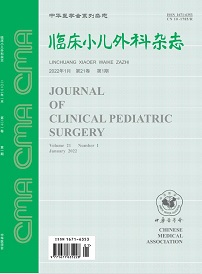Yan Bin,Wang Zhe,Zhang Yuliang,et al.Analysis of influencing factors for anastomotic stricture after thoracoscopic repair of type Ⅲ congenital esophageal atresia[J].Journal of Clinical Pediatric Surgery,,():35-38.[doi:10.3760/cma.j.cn101785-202410044-007]
Analysis of influencing factors for anastomotic stricture after thoracoscopic repair of type Ⅲ congenital esophageal atresia
- Keywords:
- Esophageal Atresia; Congenital; Thoracoscopy; Postoperative Complications; Surgical Stomas; Constriction; Pathologic; Anastomotic Leak; Root Cause Analysis; Child
- Abstract:
- Objective To explore the influencing factors of anastomotic stricture after thoracoscopy in children with type Ⅲ congenital esophageal atresia (CEA). Methods A retrospective analysis was conducted for clinical data of 33 children with type Ⅲ CEA undergoing thoracoscopy at Guangzhou Women & Children’s Medical Center from January 2017 to January 2021.Patients with dysphagia requiring balloon dilatation during follow-ups were categorized into stricture group while those without these complications were assigned into non-stricture group.Potential influencing factors such as gender,weight,gestational age,gap length and anastomotic leakage were examined for determining their association with postoperative anastomotic stricture. Results Among them,7 cases developed anastomotic stricture.Univariate analysis indicated that postoperative gastroesophageal reflux (χ2=6.046,P=0.014) and anastomotic leakage(χ2=7.757,P=0.005) were significantly associated with anastomotic stricture after thoracoscopy (P<0.05).Multivariate stepwise Logistic regression analysis identified anastomotic leakage (OR=19.167,95%CI:2.868-189.764,P=0.004) as an independent risk factor for postoperative anastomotic stricture in CEA children (P<0.05). Conclusions Anastomotic leakage is an independent risk factor for anastomotic stricture after thoracoscopic repair of type Ⅲ CEA.Optimizing surgical techniques and postoperative managements for preventing anastomotic leakage is crucial for enhancing postoperative quality-of-life in type Ⅲ CEA children.
References:
[1] 蔡威, 孙宁, 魏光辉.小儿外科学[M]. 第5版.北京:人民卫生出版社, 2014. Cai W, Sun N, Wei GH.Pediatric surgery[M]. Edition V, Beijing:People’s Medical Publishing House, 2014.
[2] Rothenberg S.Thoracoscopic repair of esophageal atresia and tracheo-esophageal fistula in neonates:the current state of the art[J]. Pediatr Surg Int, 2014, 30(10):979-985.DOI:10.1007/s00383-014-3586-7.
[3] Yamoto M, Urusihara N, Fukumoto K, et al.Thoracoscopic versus open repair of esophageal atresia with tracheoesophageal fistula at a single institution[J]. Pediatr Surg Int, 2014, 30(9):883-887.DOI:10.1007/s00383-014-3554-2.
[4] 郑珊.先天性食管闭锁治疗的发展、现状与展望[J]. 中华小儿外科杂志, 2014, 35(8):561-563.DOI:10.3760/cma.j.issn.0253-3006.2014.08.001. Zheng S.Developments, current status and future prospects in the treatment of congenital esophageal atresia[J]. Chin J Pediatr Surg, 2014, 35(8):561-563.DOI:10.3760/cma.j.issn.0253-3006.2014.08.001.
[5] 黄金狮, 陈快, 陶俊峰, 等.胸腔镜手术治疗先天性食管闭锁并食管气管瘘69例报告[J]. 中华小儿外科杂志, 2014, 35(6):414-418.DOI:10.3760/cma.j.issn.0253-3006.2014.06.004. Huang JS, Chen K, Tao JF, et al.Thoracoscopic repair of congenital esophageal atresia in neonates:a report of 69 cases[J]. Chin J Pediatr Surg, 2014, 35(6):414-418.DOI:10.3760/cma.j.issn.0253-3006.2014.06.004.
[6] 梁翠萍, 耿岚岚, 杨敏, 等.球囊扩张治疗先天性食管闭锁修复术后吻合口狭窄疗效分析[J]. 中华小儿外科杂志, 2014, 35(8):577-581.DOI:10.3760/cma.j.issn.0253-3006.2014.08.005. Liang CP, Geng LL, Yang M, et al.Efficacy of endoscopic balloon dilatation in treating anastomotic strictures after repairing congenital esophageal atresia[J]. Chin J Pediatr Surg, 2014, 35(8):577-581.DOI:10.3760/cma.j.issn.0253-3006.2014.08.005.
[7] Parolini F, Leva E, Morandi A, et al.Anastomotic strictures and endoscopic dilatations following esophageal atresia repair[J]. Pediatr Surg Int, 2013, 29(6):601-605.DOI:10.1007/s00383-013-3298-4.
[8] 赵亮, 赵宝红, 吴晓霞, 等.胃镜下球囊扩张治疗食管闭锁术后吻合口狭窄疗效的探讨[J]. 中华小儿外科杂志, 2023, 44(9):789-793.DOI:10.3760/cma.j.cn421158-20230430-00203. Zhao L, Zhao BH, Wu XX, et al.Efficacy of gastroscopy assisted balloon dilation for anastomotic stricture after esophageal atresia surgery[J]. Chin J Pediatr Surg, 2023, 44(9):789-793.DOI:10.3760/cma.j.cn421158-20230430-00203.
[9] 贾炜, 钟微, 张靖, 等.先天性食管闭锁术后食管狭窄的诊治[J]. 中华小儿外科杂志, 2008, 29(12):711-713.DOI:10.3760/cma.j.issn.0253-3006.2008.12.003. Jia W, Zhong W, Zhang J, et al.Evaluation of postoperative anastomotic strictures in infants with esophageal atresia[J]. Chin J Pediatr Surg, 2008, 29(12):711-713.DOI:10.3760/cma.j.issn.0253-3006.2008.12.003.
[10] Pelizzo G, Destro F, Selvaggio GGO, et al.Esophageal atresia:nutritional status and energy metabolism to maximize growth outcome[J]. Children (Basel), 2020, 7(11):228.DOI:10.3390/children7110228.
[11] Ten Kate CA, Teunissen NM, van Rosmalen J, et al.Development and validation of a condition-specific quality of life instrument for adults with esophageal atresia:the SQEA questionnaire[J]. Dis Esophagus, 2023, 36(6):doac088.
[12] Okuyama H, Tazuke Y, Ueno T, et al.Learning curve for the thoracoscopic repair of esophageal atresia with tracheoesophageal fistula[J]. Asian J Endosc Surg, 2018, 11(1):30-34.DOI:10.1111/ases.12411.
[13] Griffiths N, James-Nunez K, Spence K, et al.The evolution of an interdisciplinary developmental round in a surgical neonatal intensive care unit[J]. Adv Neonatal Care, 2021, 21(1):E2-E10.DOI:10.1097/ANC.0000000000000741.
[14] Wang B, Tashiro J, Allan BJ, et al.A nationwide analysis of clinical outcomes among newborns with esophageal atresia and tracheoesophageal fistulas in the United States[J]. J Surg Res, 2014, 190(2):604-612.DOI:10.1016/j.jss.2014.04.033.
Memo
收稿日期:2024-10-18。
基金项目:广州市科技项目(202201020614)
通讯作者:何秋明,Email:qiuminghe@foxmail.com
